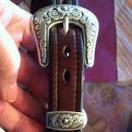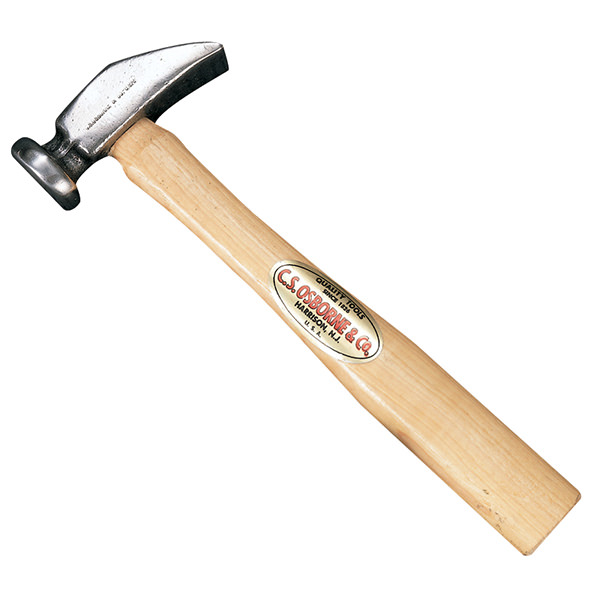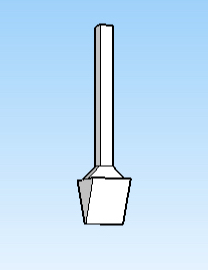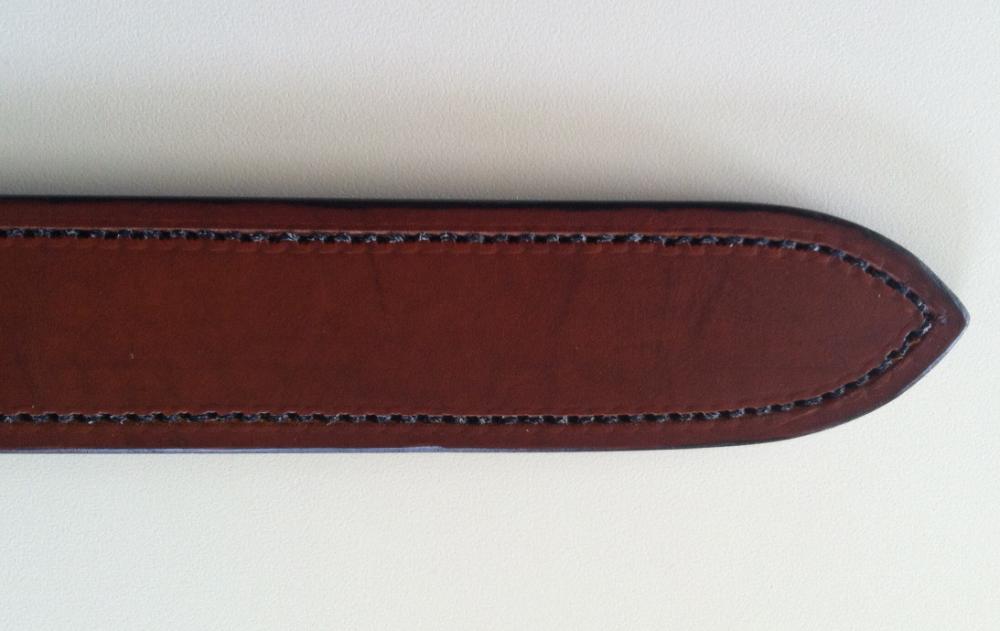-
Posts
188 -
Joined
-
Last visited
Content Type
Profiles
Forums
Events
Blogs
Gallery
Everything posted by llucas
-

Stitches on repaired machine: ready to rock-n-roll?
llucas replied to llucas's topic in Leather Sewing Machines
I have to agree with you: hand stitching is much nicer. But with demand building for the belts and holsters, I can no longer afford the time. It is not cost effective. I like your comment about the softer leather on the back. I am thinking of switching to English Bridle leather for the front, but staying with natural veg tan for the back. -

Stitches on repaired machine: ready to rock-n-roll?
llucas replied to llucas's topic in Leather Sewing Machines
Thanks for the information, Tor. All my experience until now is hand stitching. Using a stitching wheel or a pricking punch with an awl, the holes made with an awl normally close up pretty quickly and tapping the stitches was rarely necessary, if at all. Stitching with a machine is a new animal for me. One example: the stitches on the back side of the leather is not nearly as nice as hand stitching. At some point I will pick up the finer points and actually be able to sew a proper job with this machine. I appreciate you and others on this forum providing good information that helps me along this path. Thanks. -

Stitches on repaired machine: ready to rock-n-roll?
llucas replied to llucas's topic in Leather Sewing Machines
Tor, you made me curious so I am ordering some Schmetz 794LR-200 needles to try out. Thanks. -

Stitches on repaired machine: ready to rock-n-roll?
llucas replied to llucas's topic in Leather Sewing Machines
I have used a regular carpenters hammer on occasion, but have been looking at this one. Has anyone used this one or something similar? What did you think of the result using this kind of hammer? The catalog description says it is good for tapping stitches. -

Stitches on repaired machine: ready to rock-n-roll?
llucas replied to llucas's topic in Leather Sewing Machines
I did not hammer the stitches on the last sample, but I think you are right, it would have helped. Here is a tool with a narrow flat edge I was thinking of making for the purpose of flattening stitches. I suppose it would be easier to grind the end of an old 1 1/2" chisel to the width of about a 415 thread. I have looked for a similar tool but have not found one -- all I have seen are hammers and seam rollers. The feed back is appreciated. -

Stitches on repaired machine: ready to rock-n-roll?
llucas replied to llucas's topic in Leather Sewing Machines
It is definitely a steep learning curve for me. I had no idea stitching with a machine could be so complex and machine repair even more complex. This forum has helped immensely. -

Stitches on repaired machine: ready to rock-n-roll?
llucas replied to llucas's topic in Leather Sewing Machines
Thanks, Tor, your feedback is appreciated. I am now interested in trying the LR needle, since my hand stitched belts have that traditional saddle stitch pattern. I lean toward the longer stitch length; especially for the heavier thread (346 to 415) I like the look of a little longer stitch length. I am trying to avoid the made in a factory look, so I will experiment more with the stitch length with these spear point needles. The documentation you mention for the Adler 205 series that is available online I have downloaded. I have most of the spacers for the various needle sizes. I used the service manual for the 205-370 as I was making adjustments to this machine. I appreciate your comments about the color of the thread. On the samples above (except for the finished sample) I used what was in the machine when I sat down to practice. I like the lighter threads on natural to light brown. On the finished sample above I used black since the edges of the scrap piece of leather were dyed black. I have been tempted a few times to return to hand stitching my work, but the encouragement of those on this forum keeps me at the task of learning to sew on a machine and repairing the Adler 205-374. Thanks again for your feedback. Very helpful, indeed. Larry -

Stitches on repaired machine: ready to rock-n-roll?
llucas replied to llucas's topic in Leather Sewing Machines
Instead of risking an entire belt, I made a five inch "belt" from scrap leather, grooved a stitch line and finished it as I would a normal belt. I changed the stitch length to seven stitches per inch and had a go with 277 on top and 207 on bottom. What do you think? Apart from the need to polish the bottom of the center presser foot and adjust for no marking of the leather, do you think the repaired Adler 205-374 is ready to rock-n-roll? -

Stitches on repaired machine: ready to rock-n-roll?
llucas replied to llucas's topic in Leather Sewing Machines
Trox, thanks for the observations. Much appreciated. Now that you mention it, the commercial belt maker who advised me uses seven stitches per inch and his belts are being sold by a large company and are in demand by customers. My hand stitched belts are seven per inch, but it is with thinner thread. I will keep working on the tension, thanks. The needles I use are Schmetz spear point. Here is a sample from a few days ago using 346 thread on top and 277 on bottom with four stitches per inch. The shorter stitches approaching the 90 degree turns are from using the reverse lever to position the needle for the turn, but admittedly, I was not concerned about straight lines or spacing. The odd thing is in reversing the stitch the tread "crossed" the underlying thread after each hole. I appreciate the help I have received on this forum. It has helped make the acquisition of a new skill easier and less baffling. I am starting to think I won't have to return to hand stitching belts, lol. -

Stitches on repaired machine: ready to rock-n-roll?
llucas posted a topic in Leather Sewing Machines
I posted this on my Adler 205-374 repair posting, but that series seems to have gone past its shelf life. So, I will ask the question again outside of that context. I think I have the Beast repaired to the point I can use it to stitch belts and holsters, but as a novice I am not certain. Here are photos of practice samples for free-handing and turning 90 degree corners. On the advice of another gun belt maker I went to 277 for the top thread and 207 for the bottom thread, changing to a 25 needle, five stitches per inch. I need feedback about whether or not you think the Beast is ready to rock-n-roll or whether it needs more fine-tuning. I have received great advice on this forum and value your opinions. Here is the top stitch of a sample. The new open toe center presser foot leaves marks, but I plan to ease the edges and polish the bottom: Here is the bottom stitch Here is the top stitch from a better angle. The belts I make will have a groove or crease to help bring the stitch flush. Do you think the machine is ready to rock-n-roll, or does it need more adjusting? -
The above photos are not great. Here is a better angle to see stitch placement. The stitches are above the surface as the presser foot does not have a ridge to press the stitch level, but on any project I do there will be a groove/crease for the stitch line. Again, your observations or criticisms are welcome. Is the Beast far enough along to risk sewing a belt on it? Or is it not quite ready? What adjustment would you do differently to improve the aesthetics of the stitch? It is difficult for me to judge as I prefer the look of the hand stitching I have used until now.
-
O.k., more adjustments made and after feedback by another belt maker I changed to a 25 needle and switched to 277 on the top and 207 on the bottom. Here is a test of double layer 7 oz veg tan, free handing and practicing turning the corner. Five stitches per inch. There is some marking of the leather by the new open toe presser foot -- I plan to slightly ease and polish the edges and bottom of this foot. Criticism/critique is welcome. What do you think of what the Beast is producing at this point? Is it ready for prime time? Here is the bottom stitch. Here is the top stitch.
-
Also, I gave some incorrect information here. I double checked with Allen this morning. The center foot should also be at 9mm -- not 8mm. The adjustment sequence is the same; lift height for both feed should be the same.
-
I am practicing on scrap using the Beast. After the help from Allen at Weaver adjusting the feet I am doing ok on the long straight runs. Where I am still having difficulty is the 90 degree turn. Still trying to figure out the optimum location of the needle in the cycle for turning the corner or putting the machine in reverse. The videos on YouTube have helped, but the cycling of my machine is slightly, ever so slightly different. Here is the holster experiment from above (before it was finished) that is the first thing I sewed with the Beast. Of course, in my newbie status I did not know the middle foot should lift with the needle in the leather when the lift lever or pedal is used -- that is now fixed. The strap in the holster I sewed this morning. You experienced Makers will see from the strap where I am still having difficulty. In the upper left corner where I started the stitch run as the second stitch starts the knot from the bobbin is on the surface. On the right hand side of the strap I managed to turn the corner by stopping close to the corner as the needle was descending. At that point I moved the needle as close to the leather as I could with the wheel and moved the stitch length lever up and down until the needle was centered on the corner and plunged the needle using the hand wheel to slightly past bottom dead center; put the stitch lever down, lifted the feet with the lever and made the 90 degree turn; lowered the feet and continued stitching to the next corner; then, same process for the next corner. So far, so good as I stitched the next long run. When I arrived at the next corner (lower left in photo) it got away from me at the corner and the feet position would not allow me to use the stitch lever to move the needle to a better spot. So, I put the needle back into the hole (slightly), lifted the feet and turned the corner, put the feet down and stitched. This left a big loop on the bottom as I continued. Frustrating being a newbie. On the plus side, the experimental holster using the old English Bridle conditioned up ok (after not knowing what it was and trying to wet mold it!) using Fibbing's Leather Balm And Atom Wax. It is not something good enough to offer a customer, but it is ok for personal use. The learning curve moving away from hand stitching and only using moldable unfinished veg tan continues.
-
Thanks, Wiz. Very helpful. Setting my machine up with the help of Allen Burkholder from Weaver put the needle and foot hitting the leather about the same time. This also cured the problem of unequal stitching in reverse. As it is now set up, in reverse the stitches hit the same hole but I was wondering about the value of the needle hitting the leather before the foot. Great help on this forum.
-
Here is another video, this time the Cowboy CB4500. In this case (at about 3:00 on the video) the foot/needle action seems to be the same as my Adler 205-374 where the needle and foot hit the leather at about the same time. Is one adjustment better than the other? Your thoughts on the question?
-
I just watched another Cobra Class 4 video on YouTube. Like the Al Bane video above, the Cobra cycles so the needle hits the leather before the center foot. Is this desirable? On my machine and other Adler 205 series videos I have seen the needle and center foot hit the leather about the same time. Is this a tomatoes/tomatos kind of thing, or does it make a difference in stitching; turning corners; etc.? Here is the video: I am assuming the Ader 205-370 series can be adjusted to do this (needle hitting the leather before the center foot) if it is a desirable feature.
-

How-To Video: Adjusting A Juki Lu-563 Class Sewing Machine
llucas replied to Uwe's topic in Leather Sewing Machines
Great video and very useful for this model. I am looking forward to your expanded service video for the Adler 205-370 series (for self-serving reasons, admittedly). In a recent phone conversation with Allen Burkholder at Weaver Leather trying to sort out the issue of presser foot timing he mentioned and complemented your skills in videography and sewing machines. Well done.- 5 replies
-
- juki lu-563
- tacsew t1563
-
(and 4 more)
Tagged with:
-
After tinkering with it a little further Allen Burkholder from Weaver returned my call and walked me through it. Here is his process for the Adler 205-374: 1. Rotate wheel to bring needle about 1/16” into the feed dog. Keep the upper presser tension adjustment knob under tension; don't remove it or the spring. 2. Loosen both blocks on presser foot bar let everything drop. Snug up. 3. Rotate with handwheel to highest position for outside feet. 4. Measure outside feet – need 9mm. 5. If not 9mm, bring needle a little lower into the feed dog, loosen lower block and adjust block down and retighten accordingly until 9mm is achieved. 6. Rotate until center presser foot is at its highest point and measure. Need about 8mm there. 7. If center foot is out of measure, loosen upper block and adjust center foot by prying it with screwdriver or finger on back of foot into correct measurement. Tighten upper block while holding foot in place. 8. Cycle the machine by hand and remeasure. Worked like a charm! Allen is a fountain of knowledge on this machine. I can now bury the needle; lift the feet clear of the leather and turn a 90 degree corner without skipping a stitch or changing the length of the stitch.
-
Next on my list. Thanks. He is indeed a great resource.
-
To complicate things, now the presser foot rod sticks in the "up" position rather than smoothly moving up and down, no matter how much the upper knob is turned to adjust the tension. The machine is now worse off than it was before, and completely out of adjustment for the presser feet. The hook timing is good. The timing of the feet is not. I oiled everything and quit for the evening.
-
I attempted to adjust this block: It did indeed cure the problem of being able to lift the center presser foot above the material. However, because I do not know how far the distance should be above the block below it, things seem to be further out of adjustment on the presser feet. Right now, when the center presser foot touches the feed dog, the tip of the needle is 15mm above the top of the feed dog. Frustrating. I can't find the answer in the service manual.
-
Ok, I checked the lift lever action in relationship to lifting the center foot. On a single thickness 8 oz leather scrap both feet will lift above the workpiece using the lever or foot pedal. However, after the needle penetrates the leather and all the way through the movement of the feed dog, center presser foot and needle toward the rear if I stop and use the lift lever the center presser barely lifts above the surface of the material. At any other point in the cycle the center and outer feet lift to the same level. On a piece of double thickness leather (about 1/4") the center foot will not lift above the material during the time the needle is in the leather. Clearly it is out of adjustment on this feature. Is this adjusted by adjusting to the relative thickness of materials using the slot and hole on the upper left region of the faceplate? The older service manual for the 205-374 describes how to adjust the center foot to the thickest material to be sewn. Or, should the adjustable block that is engaged by the flat bar when the lever is lifted be adjusted slightly downward to achieve greater lift height for the lift lever? I should note that my foot pedal for lifting the feet needs a chain instead of the cable the last owner used -- when I use the pedal it does not lift high enough to disengage the upper tension plate, although it will release the feet to engage the leather. Also, when I manipulate by hand the long arm on the back of the machine to which the cable is attached, it does not lift the adjustable block for disengaging the presser feet bar high enough when fully depressed downward to open the upper tension adjuster plates. Looking at the adjustment blocks on the outer presser feet bar, it appears the adjustable block directly above the one used to adjust the outer presser feet height is not quite low enough for the presser foot activation lever to engage sufficiently to lift the outer presser foot bar high enough to disengage the tension plate. Does this maladjustment also affect the height of the center presser foot when disengaged by the lift lever or foot pedal?
-
Thanks, Tinker and Uwe. The foot action on my machine follows the profile in Uwe's video. I will double check the lift issue, but as I recall for part of the cycle the lever or pedal does not lift the center foot. I'll confirm this and get back to you. I used Uwe's video on adjusting the foot lift to 10mm. There was a difference in my machine in that there was no spring between the two adjustment blocks, and the lift mechanism gave me trouble thereafter -- because the adjustment block (lift block?) directly above the foot lift adjustment block needs to be adjusted also? I posted on this issue in the past on this discussion, but for some reason several posts have disappeared.
-
The servo is quite a bit smaller than the old clutch motor that was replaced. This one is providing power for an Adler 205-374 which is a large and heavy machine. It is rated at 3/4 horsepower. You had expressed a concern about cost: the motor and the reducer pulley were $265 (USD) plus shipping fees -- altogether less than $300.







